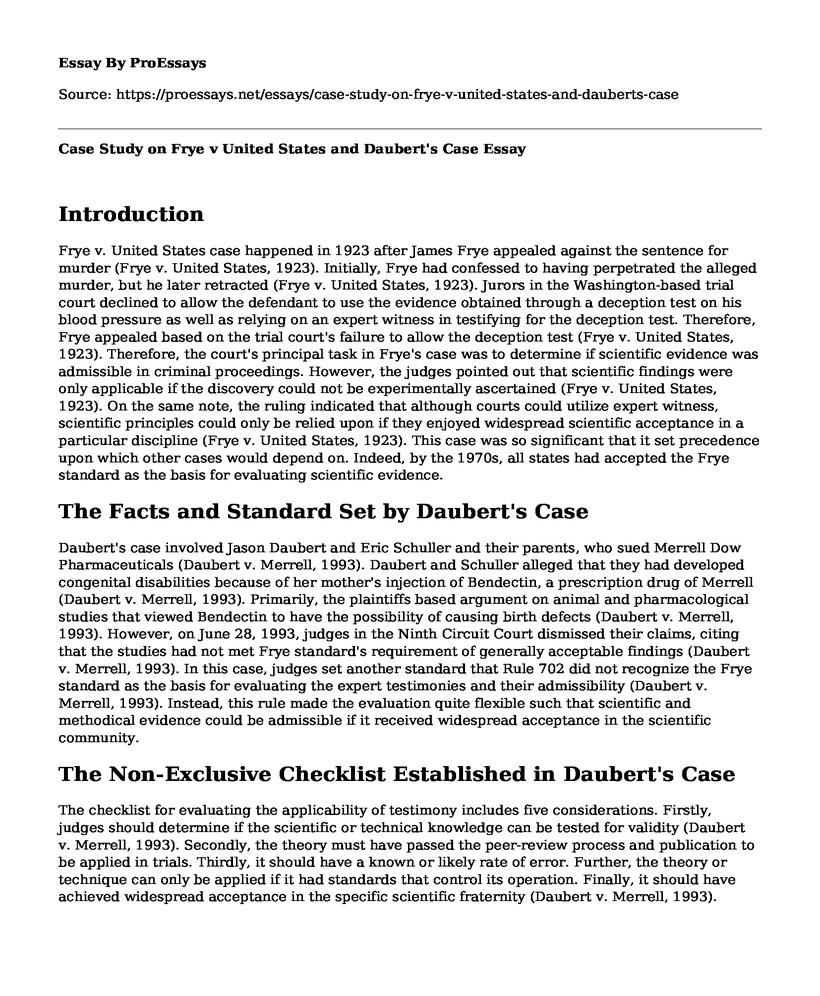Introduction
Frye v. United States case happened in 1923 after James Frye appealed against the sentence for murder (Frye v. United States, 1923). Initially, Frye had confessed to having perpetrated the alleged murder, but he later retracted (Frye v. United States, 1923). Jurors in the Washington-based trial court declined to allow the defendant to use the evidence obtained through a deception test on his blood pressure as well as relying on an expert witness in testifying for the deception test. Therefore, Frye appealed based on the trial court's failure to allow the deception test (Frye v. United States, 1923). Therefore, the court's principal task in Frye's case was to determine if scientific evidence was admissible in criminal proceedings. However, the judges pointed out that scientific findings were only applicable if the discovery could not be experimentally ascertained (Frye v. United States, 1923). On the same note, the ruling indicated that although courts could utilize expert witness, scientific principles could only be relied upon if they enjoyed widespread scientific acceptance in a particular discipline (Frye v. United States, 1923). This case was so significant that it set precedence upon which other cases would depend on. Indeed, by the 1970s, all states had accepted the Frye standard as the basis for evaluating scientific evidence.
The Facts and Standard Set by Daubert's Case
Daubert's case involved Jason Daubert and Eric Schuller and their parents, who sued Merrell Dow Pharmaceuticals (Daubert v. Merrell, 1993). Daubert and Schuller alleged that they had developed congenital disabilities because of her mother's injection of Bendectin, a prescription drug of Merrell (Daubert v. Merrell, 1993). Primarily, the plaintiffs based argument on animal and pharmacological studies that viewed Bendectin to have the possibility of causing birth defects (Daubert v. Merrell, 1993). However, on June 28, 1993, judges in the Ninth Circuit Court dismissed their claims, citing that the studies had not met Frye standard's requirement of generally acceptable findings (Daubert v. Merrell, 1993). In this case, judges set another standard that Rule 702 did not recognize the Frye standard as the basis for evaluating the expert testimonies and their admissibility (Daubert v. Merrell, 1993). Instead, this rule made the evaluation quite flexible such that scientific and methodical evidence could be admissible if it received widespread acceptance in the scientific community.
The Non-Exclusive Checklist Established in Daubert's Case
The checklist for evaluating the applicability of testimony includes five considerations. Firstly, judges should determine if the scientific or technical knowledge can be tested for validity (Daubert v. Merrell, 1993). Secondly, the theory must have passed the peer-review process and publication to be applied in trials. Thirdly, it should have a known or likely rate of error. Further, the theory or technique can only be applied if it had standards that control its operation. Finally, it should have achieved widespread acceptance in the specific scientific fraternity (Daubert v. Merrell, 1993).
Key Differences Between the Two Decisions
The principal difference between the two decisions is that in Frye's case, the judges adopted a narrower view of evaluating expert testimony than in the case of Daubert. In particular, the judges in the Frye case evaluated the testimony based on how such knowledge is generally accepted (Daubert v. Merrell, 1993). However, in Daubert's decision, judges expanded the evaluation to a two-faceted approach. In this case, they considered if an expert is qualified to provide guidelines in a specific field as well as the methodologies utilized in arriving at such conclusions (Daubert v. Merrell, 1993). Another difference is that in deciding Frye's case, judges did not apply the Federal Rules of Evidence. However, in Daubert's case, they included Rule 702, and perhaps that is why they extended their assessment (Daubert v. Merrell, 1993).
References
Daubert v. Merrell Dow Pharmaceuticals, Inc., 509 U.S. 579 (United States Supreme Court 1993). Retrieved from https://caselaw.findlaw.com/us-supreme-court/509/579.html
Frye v. United States. 293 F. 1013 ( D.C.. Cir 1923). Retrieved from https://www.law.ufl.edu/_pdf/faculty/little/topic8.pdf
Cite this page
Case Study on Frye v United States and Daubert's Case. (2023, Mar 30). Retrieved from https://proessays.net/essays/case-study-on-frye-v-united-states-and-dauberts-case
If you are the original author of this essay and no longer wish to have it published on the ProEssays website, please click below to request its removal:
- Maya Angelou Speech on Coretta Scott King
- Essay on the 13th (2016) Documentary: Revelation of a High Number of Black Americans in Prison
- Paper Example: Legalization of Marijuana
- Strict Product Liability: Calles v. Scripto-Tokai Corp. Case Paper Example
- Philosophical and Practical Approach for Balancing Issues in Criminal Justice - Essay Sample
- Essay Sample on Lowering Hospital Readmission Rates with Effective Strategies
- Essay Example on Women's Suffrage: A Philosophical Process of Civil Rights Transformation







